|
Size: 19310
Comment:
|
← Revision 62 as of 2013-10-27 21:49:30 ⇥
Size: 19311
Comment:
|
| Deletions are marked like this. | Additions are marked like this. |
| Line 205: | Line 205: |
| * lick on a data table or results tab, choose '''File -> Export''' to export the data as a .txt file | * Click on a data table or results tab, choose '''File -> Export''' to export the data as a .txt file |
Working with Prism 6.0
Basics: (t-test example)
Basics
When you launch Prism 6, you’ll see the following window:
Choose whether you want to create a new file, or open an existing file. If creating a new file, you’ll need to choose the appropriate format for your data table. Note on the left navigation bar, there are multiple options (XY, column, grouped, etc). For each of these options, the main window describes the type of data to be entered, and also displays the format of the data table. The radio buttons on this page allow you to indicate the nature of the data to be entered. If you are unsure how the table should be formatted, you can choose one of the sample data sets to see various examples. When a sample data table is selected, there will be further information displayed about the sample data and step-by-step instructions for performing the selected analysis.
Data table setup
For now, set the parameters as in the figure above (“replicate values stacked into columns): this would be appropriate for an unpaired t-test where individual data points are entered.
The data table will look like the image below.
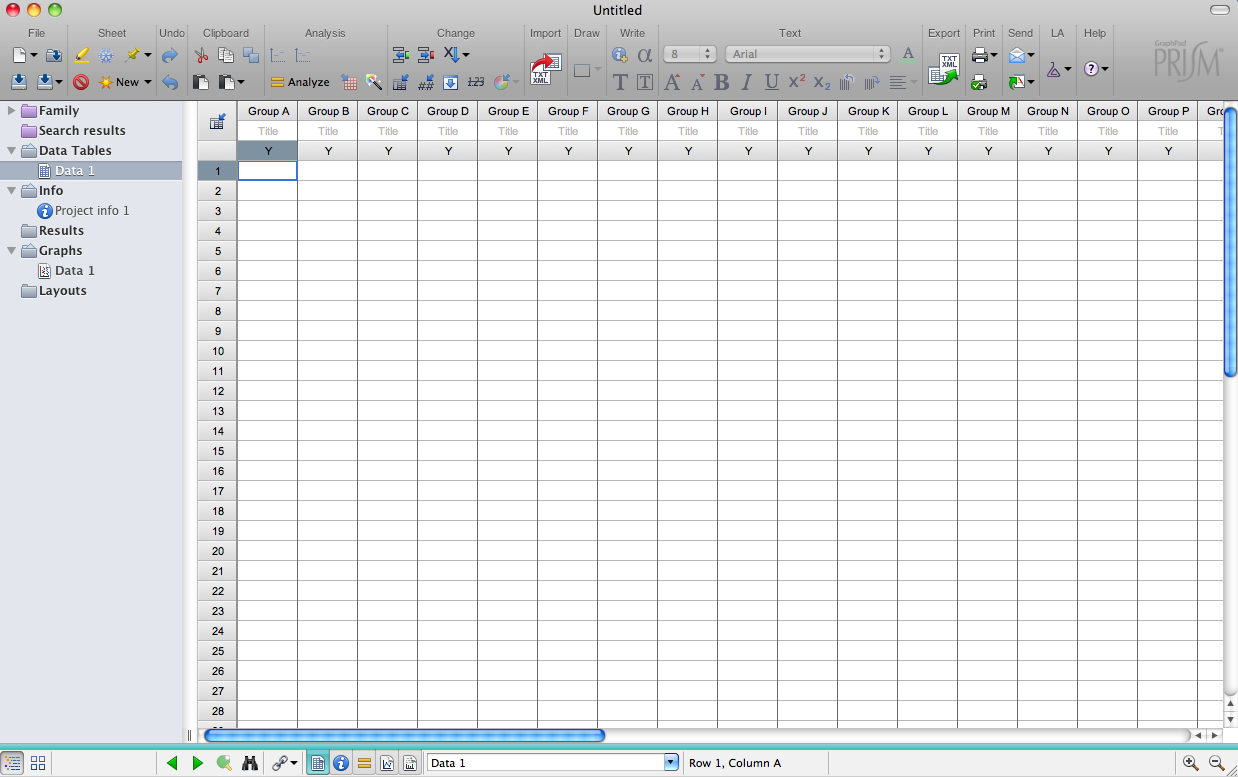
Next, Enter the Blood Pressure data from the Wiki, placing each data set into a different column, starting with the left-most column. If control data exist, put it in the first column, which will place it in the leftmost portion of any graph. The rationale here is that graphs (and tables) are read left to right, and baseline (control) information is the benchmark needed to interpret other experimental groups. Label the columns (click header). Also, on the left sidebar, label the data table “e.g., “Blood Pressure”. Save your data file (and do this regularly as you work).
Your data table should now look like the image below.
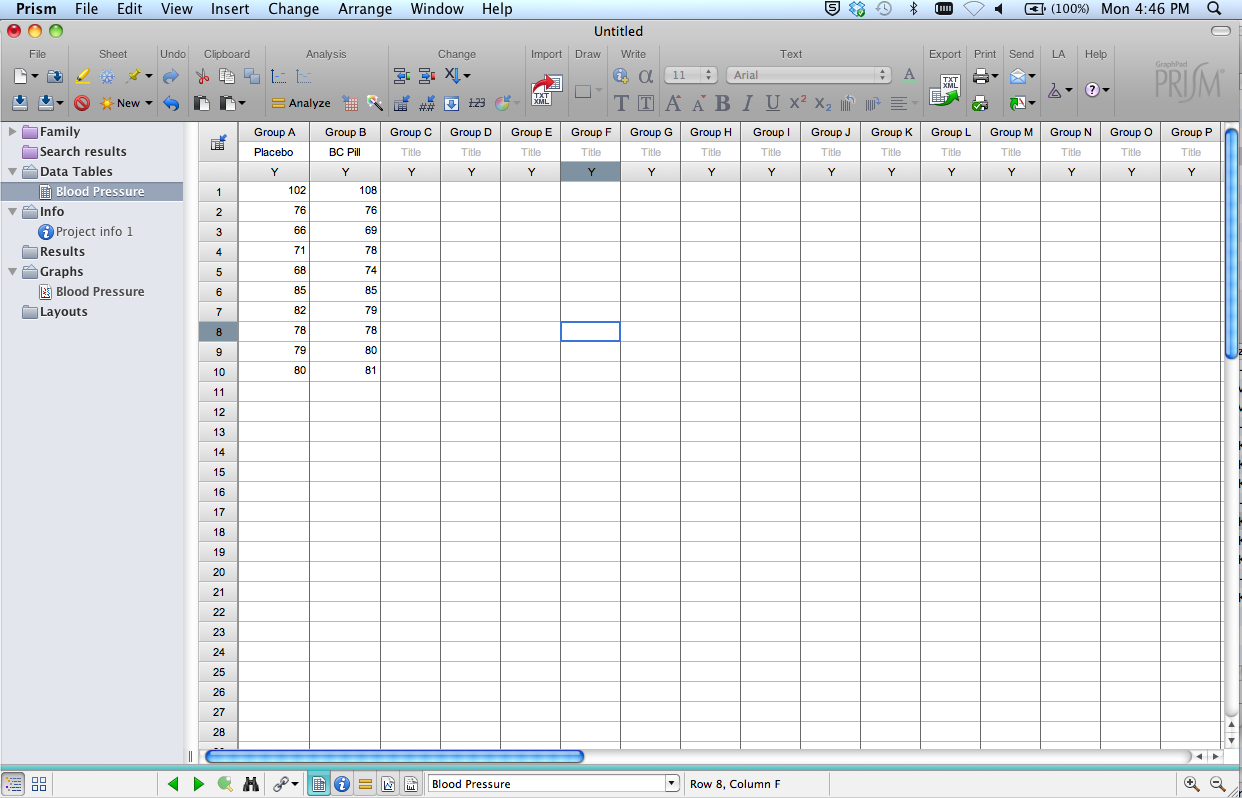
Note several other items in this window:
- Sidebar: Folders that organize Data, Info, Results, etc. This is generally how you’ll move between different elements of your project. At the top is a folder labeled “Family”. This contains all components (data table, analyses, graphs) related to the data that you currently have selected.
- “New”, “Analyze”, “Change” buttons along the top of the window. These work in concert with the folders in the sidebar. For example, if you’re in a data window, click “New” to add a new data table, or a new graph, etc. Click “Analyze” to choose an analysis to perform on the data table you’re in. Select one of the options under “Change” to change the format of the data table you’re in, insert a row of data, etc. Similarly, if you’re on a graph page, you can add a new graph of a data set, and/or change the format of a graph already created. A description of each function appears when the cursor hovers over an icon.
- Main Menus (across top). These provide many different options (eg., delete a graph, reorder sheets, open/create a different data file, etc). Some of these options are duplicates of those given in the “New”, “Analyze”, “Change” menus described above. Move your cursor over the Main Menu options to see what’s available.
NOTE: There are times you’ll want to enter data as mean, SD (or SEM), n. These options are given in the Data Table setup window. In the current example, if you select Change>Format Data Table, you could reformat the table to receive group statistics rather than individual data points. Just be careful when choosing this format: if you choose mean/SD format but enter mean/SEM data (or vice versa), your statistics will be incorrect!
Graphs
As soon as you create a data table, Prism also creates a graph.
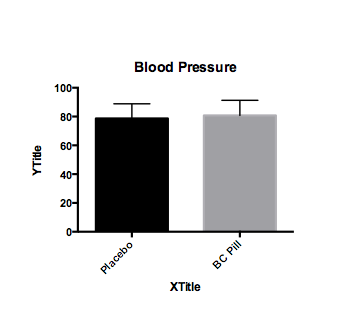
For the Blood Pressure data entered in this tutorial, the default graph might looks like the figure above. You can modify the format by clicking on CHANGE>Graph type. You can modify virtually all other elements of the graph by clicking on the axis, text, etc, or by selecting an option available in the CHANGE menu. Don’t forget to appropriately label the Y axis.
Note that if you choose NEW>graph of existing data, you can create another graph of the data rather than modify the format of an existing graph. If you do this, you should title the graphs appropriately so they are easily identified in the sidebar.
Analysis setup
Once a Data Table is filled and labeled, click the “Analyze” button. The following window will appear: 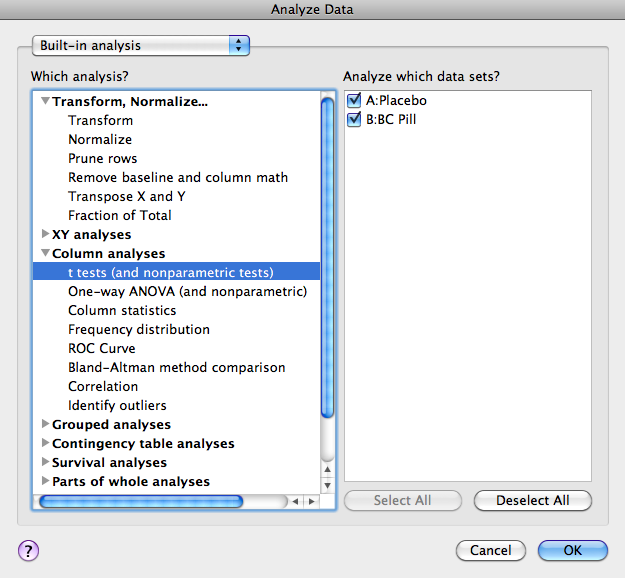
Under Column Analysis select “t-tests (and nonparametric tests).” Click OK.
Next, set the parameters for your analysis. First, the “Experimental Design” window will open for selecting the type of analysis to complete. For now, select unpaired, parametric test. Note that parametric tests assume equal variance between groups. If variance is not equal, nonparametric statistics should be chosen.
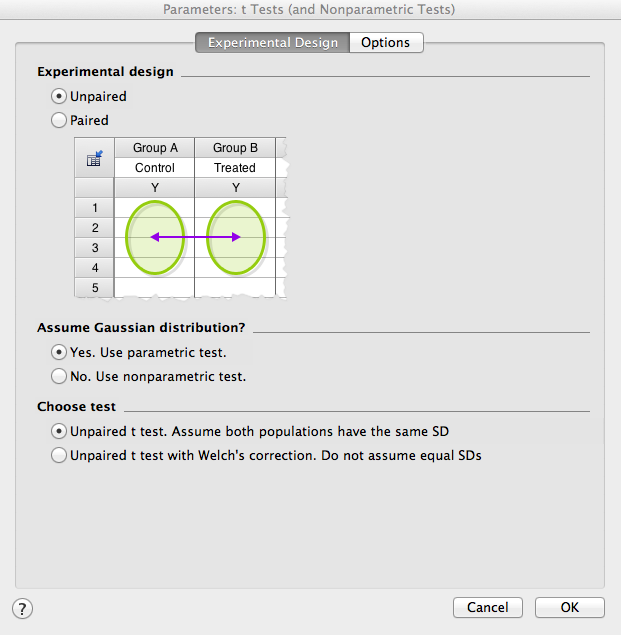
Next, click on “Options” (at the top of the window). Most often, you would use a 2-tailed test (make sure you understand why!). For “Report difference as”, make sure the order is left then right columns so as to avoid confusion. Finally, set the confidence level to 95% (e.g., p<.05). For now, ignore the other options (though you might want to select “Descriptive Statistics”, which will generate a secondary results page with some useful information).
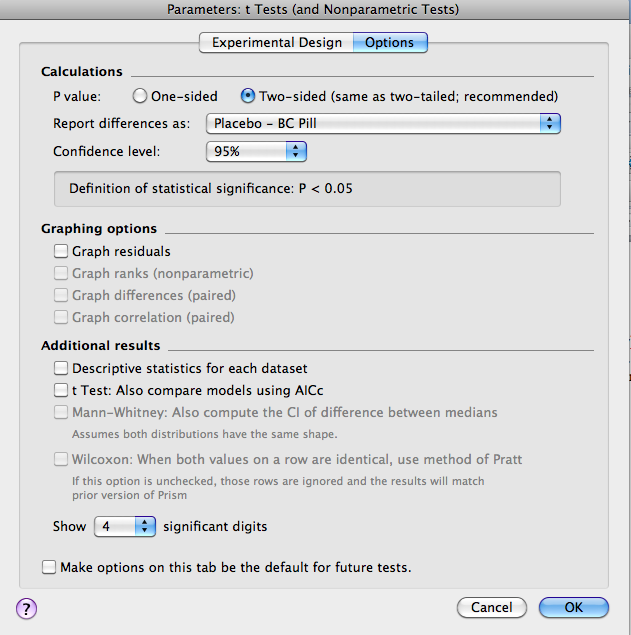
Results
You should now see the tabular results (shown below) of the analysis selected. This window describes which data table was analyzed, what type of analysis was run, and the results of that analysis. Note that in this example, t=0.4542, df=18. The p = .6551, therefore the means are NOT significantly different from one another. Some additional statistics are also reported, including means +/- SEM. Always check these values against your original data set (usually from an Excel spreadsheet) to catch any errors in data entry. Also shown in the analysis window are the results of an F test to compare whether the variance in the two groups differs significantly. If the variance is significantly different between groups, a nonparametric test should be used. To do this, click on the blue text at the top of the results window (it now shows “Unpaired t-test with equal SD”). This will reopen the Parameters window so you can choose a nonparametric test (under the experimental design tab).
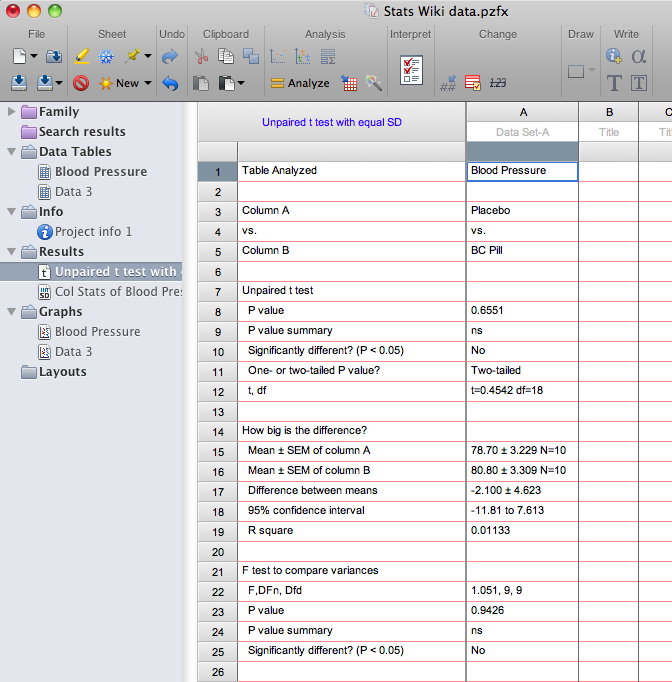
NOTE: If you realize that a paired t-test should have been used, this is easily corrected. Click on the blue text that tells you what test results are being displayed (or click on CHANGE>Analysis Parameters up in the top menus); choose the Experimental Design tab, and then select a paired t-test. The results window will now specify that the results reflect a paired t-test. If you do this for the Blood Pressure Data, you’ll find t=2.024, df = 9. The p=.0737, a value that approaches statistical significance (and is MUCH smaller than that obtained from an unpaired t-test). The results window also shows a statistically significant effect of pairing. Finally, for a paired t-test, the data are best depicted by a line graph that shows the paired values (see below). Go to the Blood Pressure graph, and use the “Change” function to make that change.
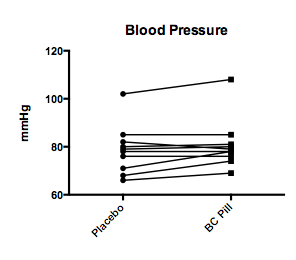
One-way ANOVA
Description: A one-way ANOVA compares the means (or medians, if nonparametric) of three or more groups that differ on only one dimension (the independent variable). The test determines if there is a significant main effect of that variable. In order to determine which groups differ, you must perform post-hoc t-tests.
Data Table setup:
Click “New > New Data Table (+ graph)", and then select COLUMN format and choose the format for the data. For this next example, the data are not repeated measures, so select “Enter replicate values, stacked into columns” (as shown below). Note that data instead could be entered as means/SEM (or SD)/N. Click OK.

- Label the Data table (e.g., TV watching) and check the graph that was created. If necessary, change the graph format and fix all labels.
Analysis setup:
- Once data are entered, click on the “Analyze” button.
Under Built-in Analysis choose “Column analysis”: "One-way ANOVA (and nonparametric".
- In the right panel, make sure all data sets are selected. Click OK.
- In the Parameters window that opens (see below), choose the appropriate experimental design. For the current data set, you should select no matching, and assume a Gaussian distribution.
- Next, click on the Multiple Comparisons tab and select the appropriate comparison. For the TV watching data, there is no “control” group and no pre-selected pair of columns that’s particularly important, so the mean of each column should be compared to the mean of every other column.
Finally, click on the Options tab and make the appropriate selections. If multiple post-hoc comparisons are being made, correct the p value for multiple comparisons (this maintains p<.05 for the family of comparisons). Also select multiplicity adjusted p value to display the adjusted (*family-wise*) p value for each individual comparison.
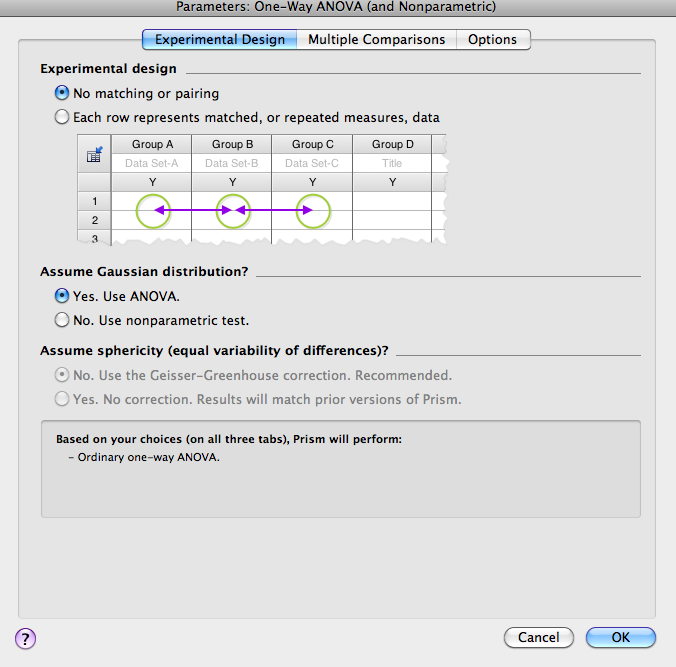
- Click OK.
Results:
You should now see the tabular results (shown below) of the analysis selected. This window describes which data table was analyzed, what type of analysis was run, and the results of that analysis. Note that for the data on TV watching, the overall F=.9188 and df = 2,12 (df for treatment=2, df for residual=12). The p = .4253, therefore there is no significant main effect of academic major on # TV hours watched per week. Also reported in this table are the results of Bartlett’s test, which evaluates whether there are significant differences in variance across groups (if there are, nonparametric statistics should be used – use the CHANGE tab to select a different test). IMPORTANT: The results of the overall ANOVA don’t tell you which (if any) groups differ from one another; only posthoc tests can evaluate specific group differences. If multiple comparisons were selected from the Analysis parameter options, there will be a second page of results reporting those results (look for this in the sidebar). In the present example, none of the posthoc comparisons are statistically significant.
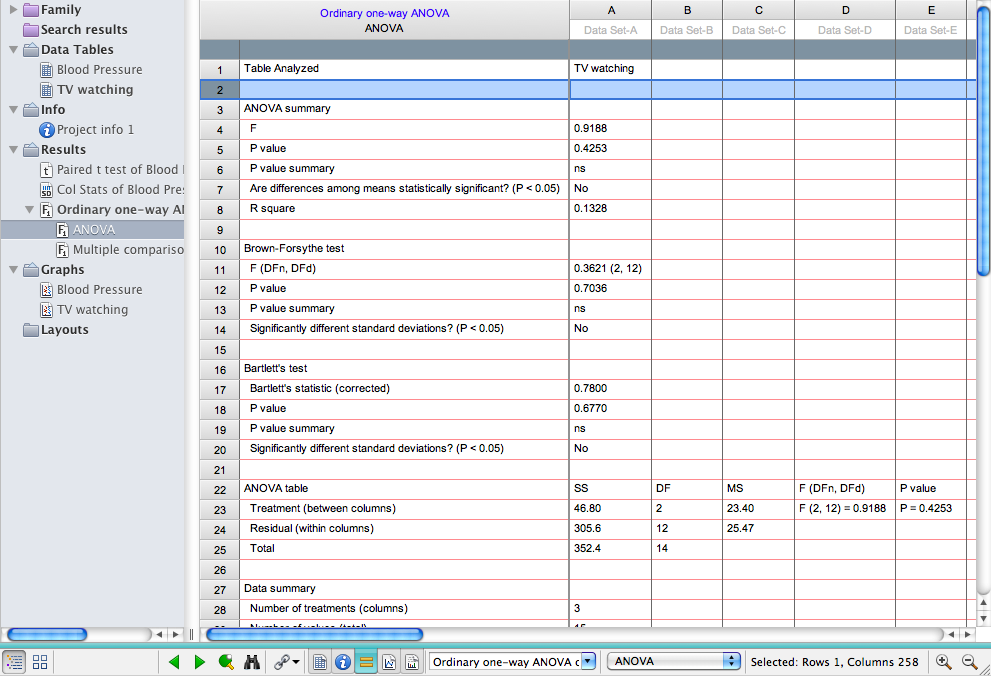
NOTE: If you realize that repeated measures ANOVA should have been used, this is easily corrected. From the ANOVA results page, click on the blue text that specifies which test was run (or, go to CHANGE> analysis parameters. The Analysis Parameters box will reopen, and in the Experimental Design tab you can select repeated measures. The results window will now specify that the statistics reported are from a RM ANOVA.
Two-way ANOVA
Description: A two-way ANOVA is used when the experimental design investigates the effects of two different independent variables (e.g., sex AND age). The test reveals if there is a significant main effect of each variable, and if there is a significant interaction between the two independent variables.
Data Table setup:
Click “New”>New Data Table (+ graph), and then select GROUPED format. Note that Column format is used for one grouping variable (t test or 1-way) while Grouped format is needed for two grouping variables (one defined by columns, the other by rows).
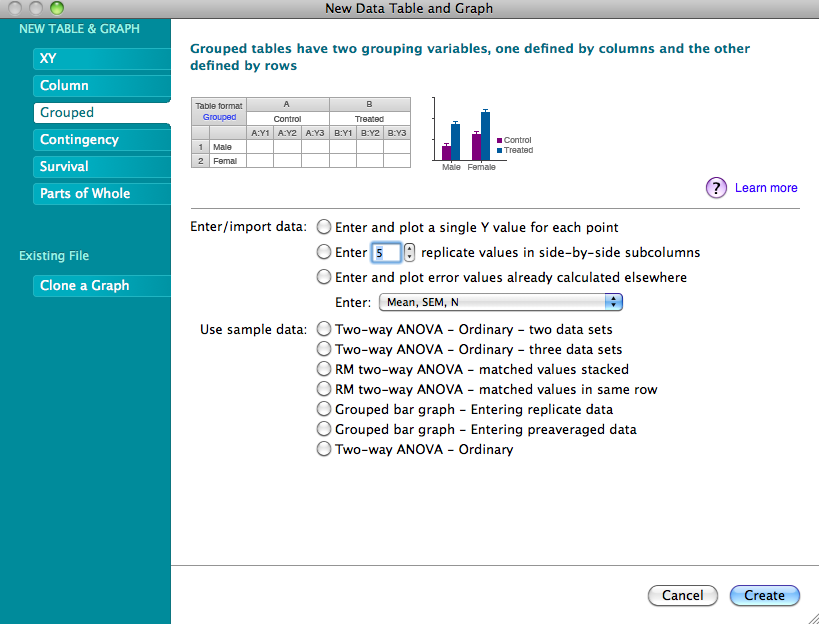
There are many ways to set up a table for a two-way ANOVA. The easiest, especially with large amounts of data, is to enter the data as mean/SD (or SEM)/n (see third radio button option in the image above). CAUTION! Double-check your selection: if you choose mean/SD format but enter mean/SEM data (or vice versa), your statistical calculations will be incorrect!
For the Spine Density data from the Wiki, the Data Table of means/SEM/n (after labeling rows and columns) should look as follows:
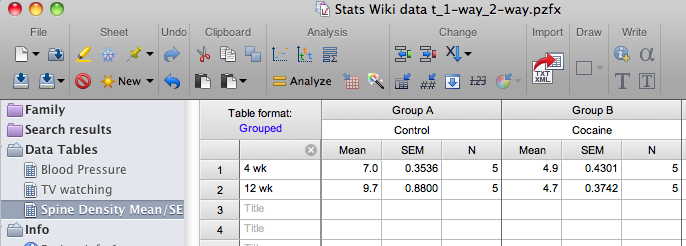
However, realize that data entry using summary statistics (such as mean, etc) does not permit a repeated measures analysis because summary data do not retain information about individual data points. If we assume the spine data are from repeated measures taken at 2 different ages (e.g., based on 2-photon imaging data), replicate measures need to be entered (in this case, 5 subjects in each treatment group). To set up the data table for that format, choose the second radio button option (for replicate values in side by side subcolumns) and enter "5" to specify the number of subjects in each treatment group.
Enter the spine density data from the Wiki.
The Data Table (after labeling rows and columns) should look as follows:

After creating the data table, be sure to label the table in the sidebar (e.g., Spine Density), and look at the graph that was created to be sure the format is optimized and all axes are labeled.
Analysis setup (continue assuming repeated measures design:
Once data are entered, click on the Analyze button.
Under Built-in analysis, choose Grouped analysis, "Two-way ANOVA".
- In right panel, make sure all data sets are selected.
- Click OK.
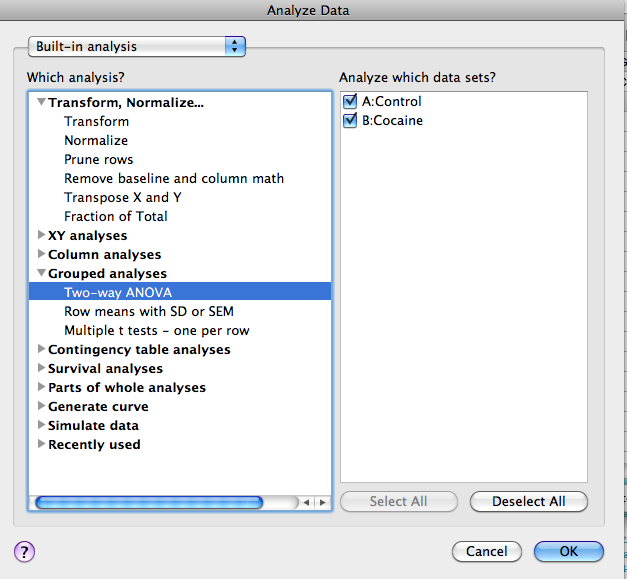
- Next, the "Experimental Design” window will open. Since each row represents a different age (repeated measures are stacked within a subcolumn), check that button. Provide labels for the columns and rows (eg, treatment and age).
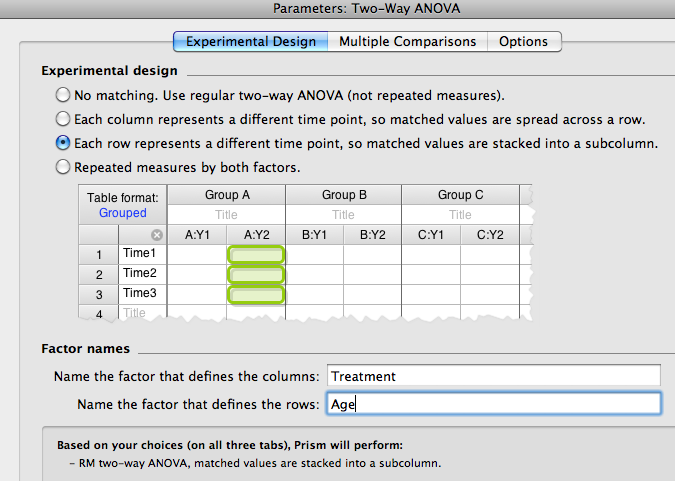
- Select the tab for Multiple Comparisons. Prism6 will not perform group comparisons across both columns and rows in a single step, so these have to be done sequentially (order is inconsequential). So, first select comparisons within each column (this will evaluate the effect of age within each treatment group).
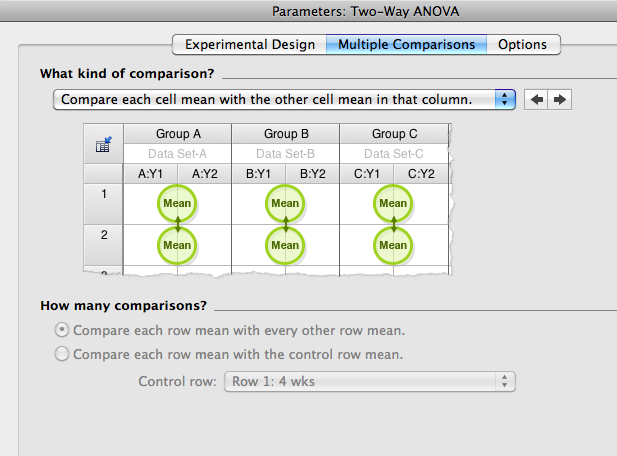
- Click on the Options tab and select to correct for multiple comparisons.
Results:
Under the tabular results (shown below) you should find there is a significant interaction between age and treatment (F (1,8) =6.2, p<.05) and a main effect of treatment (F(1,8 = 44.8, =.0002), and an effect of age that approaches significance.
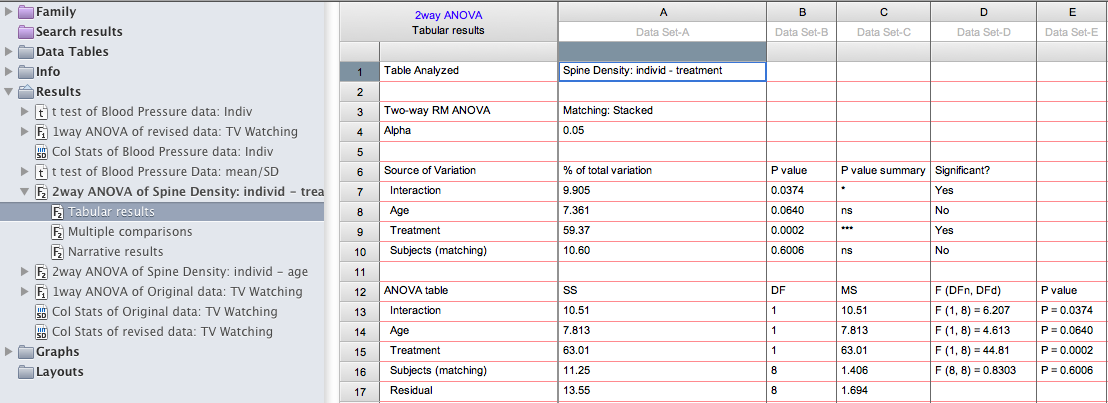
Interpreting two-way ANOVAs:
Interaction: The interaction term means that the effect of one factor depends on the other factor. A significant interaction makes it particularly difficult to interpret the main effects. For this reason, the presence of an interaction should be noted before describing any main effects. Post-hoc tests help explain what underlies a significant interaction term.
Main effects: these are calculated by collapsing across levels of one variable and then evaluating group differences between levels of the other variable. They should be reported as “ a significant main effect of XX…”, as written above. Note that a significant main effect of one variable (eg,, treatment) does not mean that this effect is evident at both levels of the other variable (e.g, at both ages). That is, a main effect of treatment could be the results of: a significant effect of treatment at only one age, or, a significant effect of treatment at one age with a nonsignificant trend in the same direction for the other age group, OR a significant effect of age in both groups. Because the main effects don’t provide details about individual group differences, it is best not to state anything about the direction of group differences when reporting main effects. Further details require information from the posthoc tests.
Posthoc tests: The results of the posthoc tests are reported on a separate results page. In the present example, they reveal that a significant developmental increase in spine density is evident in controls (t=3.3, p<.05) but not in cocaine-exposed animals (see below).
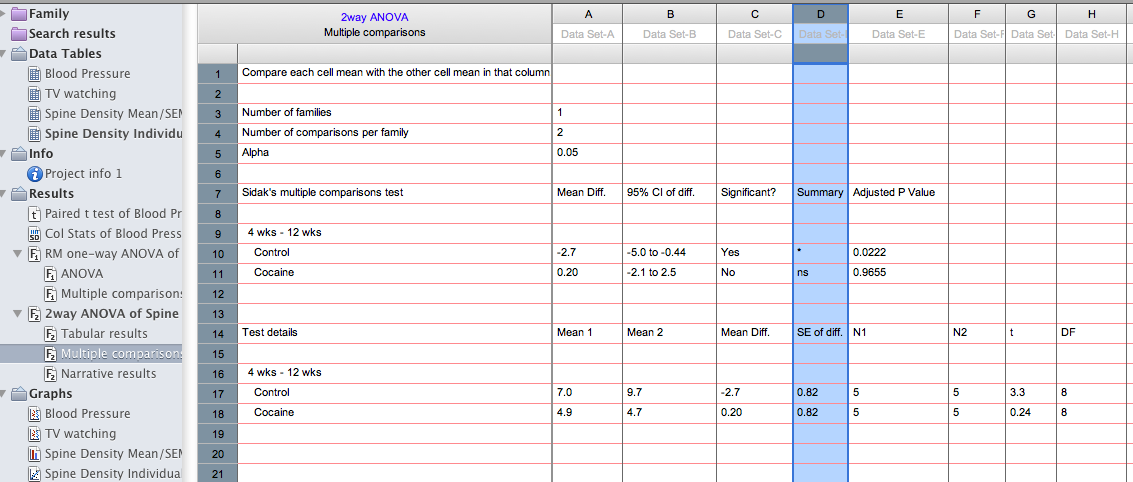
To evaluate group differences at each age, you’ll need to change the analysis parameters (Click Change>Analysis Parameters>Multiple Comparisons, and select compare each cell mean with the other cell mean in that row. These results (see below) reveal that there is a significant group difference at the earliest age, and this difference is magnified with age (4 wks: t=2.7, p<.05; 12 wks: t=6.4, p<.0001).

Taken together, the posthoc tests show that prenatal cocaine exposure prevents a developmental increase in spine density that normally occurs between 4-12 weeks of age, and results in a lower density of spines at both 4 and 12 weeks after birth.
Exporting Data/Graphs from Prism
Prism6 saves files in the .pzfx format, which is meaningless to anything but Prism.
There are several ways to get your files to a readable format elsewhere
Click on a data table or results tab, choose File -> Export to export the data as a .txt file
Click on a graph, choose File -> Export to export the graph as a PDF, TIF, or other image format
- Highlight the data you want and copy it into Word or Excel
- From any graph, copy and then paste into another document
- On macs, use command-shift-4 to take a screen shot. This turns your mouse into a cross hair. Click and drag to create a box around the area you want to capture, then release to take the shot. The image should appear on the desktop as a .png file, which is readable by most programs. If you capture your stats in this way, you won’t be able to edit them, but you can see the values you need.
